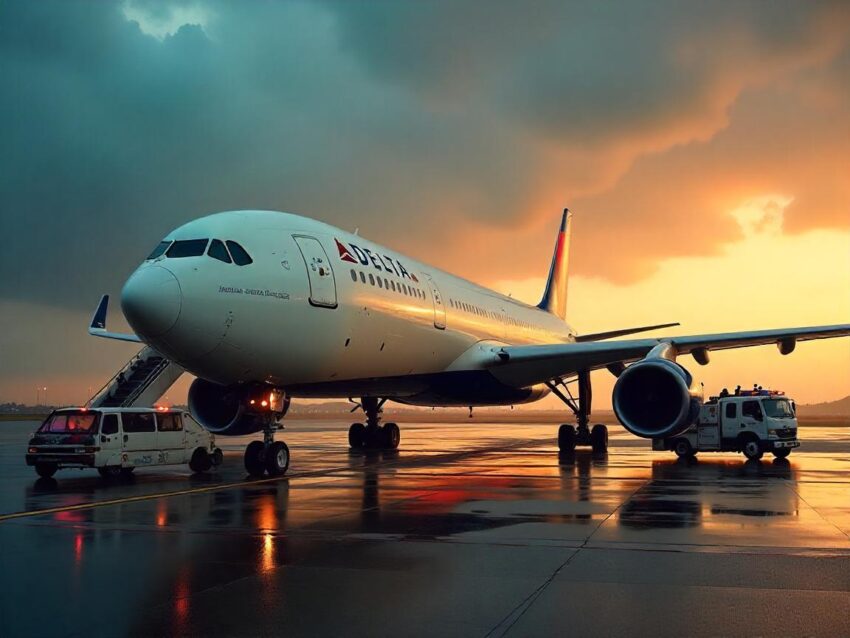
Delta Air Lines’ Airbus A330 was severely damaged by a sudden hailstorm, forcing an emergency landing back in Barcelona. This unexpected turn of events has left travelers on edge, raising questions about flight safety in extreme weather conditions. The aircraft, which was en route from Barcelona to New York JFK, encountered a severe hailstorm shortly after takeoff, causing significant damage that led to the flight’s return. Passengers on board experienced an alarming situation, and the aircraft is now grounded for extensive inspections.
What does this mean for air travel, and how will it impact the safety protocols of airlines going forward? With more details emerging, this incident highlights the unpredictable nature of weather and the vital importance of quick responses from flight crews. Keep reading to find out what travelers need to know about this emergency landing and the ongoing investigation into the damage caused by the storm.
The Sequence of Events: From Takeoff to Emergency Landing
Flight DL169 had just taken off from Barcelona, climbing toward its cruising altitude of 20,000 feet when disaster struck. The aircraft flew directly into a fierce hailstorm, a sudden and severe weather event that took the flight crew by surprise. The turbulence and damage were so significant that the pilots had no choice but to immediately descend to 8,000 feet, circling the coast near Costa Brava as they awaited clearance to return to Barcelona.
As the plane returned to its departure point, the pilots successfully performed an emergency landing, safely bringing the passengers back to the ground without incident. The visible damage to the aircraft was alarming: a large dent on the nose and widespread hail impact marks across the radome were evident. Passengers deplaned via mobile airstairs, indicating the urgency of the situation.
The 9-year-old Airbus A330-300, grounded at Barcelona El Prat for detailed inspections, has raised many questions about the vulnerability of aircraft to severe weather, especially during summer months when such storms can develop rapidly.
The Aftermath: Grounding for Inspections
Following the emergency landing, Delta Air Lines immediately grounded the aircraft for further inspections. These inspections are crucial in assessing whether the damage could have compromised the aircraft’s structural integrity, particularly to critical components such as the radome and fuselage. Although hailstorms are not uncommon in certain regions, this particular incident shines a spotlight on the unpredictable nature of such weather phenomena and the aviation industry’s ongoing commitment to safety.
Despite the significant damage, Delta’s handling of the situation shows their unwavering commitment to passenger safety. The decision to immediately ground the aircraft and conduct a thorough inspection reflects a prioritization of operational safety, a move that will undoubtedly be mirrored by airlines around the world facing similar threats.
Delta’s History with Hailstorms and Operational Disruptions
The emergency landing of flight DL169 is far from an isolated incident for Delta. In recent months, the airline has experienced multiple disruptions caused by hailstorms, which have led to grounded aircraft for detailed inspections. Just weeks prior, severe weather, including hailstorms, forced Delta to ground approximately 100 aircraft at its primary hub at Atlanta Hartsfield-Jackson International Airport (ATL). These aircraft were quickly removed from service and underwent expedited overnight inspections before being cleared for flights the following morning.
In July 2023, Delta faced a particularly challenging incident when a Boeing 767, departing from Milan Malpensa Airport (MXP), was struck by hail shortly after takeoff. The flight was diverted to Rome (FCO), where substantial damage, including engine fan blade impacts and cracked windshields, required significant repairs before the aircraft was cleared for future use.
These recurrent incidents serve as a reminder of how critical weather-related challenges are to the aviation industry. While airlines are well-prepared for many in-flight challenges, hailstorms and other severe weather events continue to pose unique risks to the integrity of aircraft and the safety of passengers.
Protocols and Procedures: Ensuring Safety Amid Storms
When severe weather strikes, Delta and other major airlines have strict protocols in place. These protocols are designed to mitigate the risks associated with turbulent weather, such as hailstorms, that could compromise the aircraft’s structural integrity.
The airline follows industry-standard safety procedures, which include immediate grounding of any affected aircraft for structural assessments. Engineers conduct thorough evaluations of the fuselage, radome, and critical engine components to ensure the aircraft is safe to return to service. Delta’s rapid response and adherence to safety standards emphasize the airline’s commitment to passenger well-being and operational safety, even in the face of unpredictable weather events.
Moreover, the incident highlights the importance of seamless coordination between flight dispatch, meteorological services, and cockpit crews. Weather conditions, especially in coastal or mountainous areas, can change rapidly, making it difficult for pilots to anticipate severe storms. As seen with this flight, the prompt reaction of the flight crew, coupled with real-time weather alerts, helped mitigate the situation.
The Global Impact: Hailstorms and Airline Operations
The incident with Delta’s Airbus A330 has far-reaching implications for the broader aviation industry. As climate change continues to influence weather patterns worldwide, airlines will need to adapt to more frequent and unpredictable weather events. Hailstorms, in particular, can be especially damaging to aircraft, with the potential to cause structural issues that compromise the safety of the flight.
Airlines must continue investing in advanced weather radar systems and more robust safety protocols to handle such challenges. Additionally, better coordination between meteorologists, flight crews, and air traffic control will be essential to navigating these unexpected weather events. The Delta incident may spark a reevaluation of how airlines manage adverse weather, with an increasing focus on minimizing delays, preventing damage, and ensuring a safe travel experience for passengers.
Passenger Reactions and Social Media Buzz
In the age of social media, news of incidents like this spreads rapidly. Eyewitnesses aboard the flight shared images of the damage to the aircraft’s nose, and many passengers expressed concern over the severity of the hailstorm. While the situation was ultimately handled safely, social media provided a platform for passengers to share their experience, generating widespread attention to the incident.
The viral nature of this news also underscores the increasing transparency in the aviation industry. Passengers today expect real-time updates on the status of their flights, particularly when incidents such as this one occur. Social media platforms like Twitter, Instagram, and Facebook are now key tools in providing immediate feedback and keeping travelers informed.
Safety, Technology, and the Future of Air Travel
As the aviation industry moves forward, ensuring passenger safety remains the top priority for all airlines. While incidents like the Delta emergency landing serve as a stark reminder of the unpredictable nature of weather, they also highlight the resilience of the aviation system. Airlines like Delta continue to refine their weather-related safety protocols, implement cutting-edge technology to detect and avoid storm systems, and invest in more advanced training for flight crews to handle extreme conditions.
This focus on safety, combined with advancements in weather forecasting and real-time communication tools, will continue to shape the future of air travel. As travelers become more aware of the risks associated with severe weather and aviation, airlines will need to respond with greater transparency, ensuring that safety protocols are not just followed, but continually improved upon.
Conclusion: The Road Ahead for Delta and the Aviation Industry
The emergency landing of Delta’s flight DL169 back in Barcelona serves as a powerful reminder of the risks associated with flying in extreme weather conditions. As the aviation industry continues to evolve, ensuring safety in the face of unpredictable storms will be paramount. The quick response by Delta Air Lines in grounding the aircraft and conducting detailed inspections is a testament to the airline’s commitment to passenger safety.
As passengers, airlines, and the aviation industry as a whole look to the future, it’s clear that weather-related incidents will continue to shape the way we travel. With ongoing advancements in weather technology and flight safety protocols, we can expect to see a continued commitment to ensuring the safety and security of every passenger, no matter the conditions outside.
The post New York Bound Delta Air Lines Airbus A330 Severely Damaged by Hailstorm Forces Emergency Landing in Barcelona, New Update Right Now Travelers Need To Know appeared first on Travel And Tour World.from Travel And Tour World https://ift.tt/rEDUWXg
via >EPR


